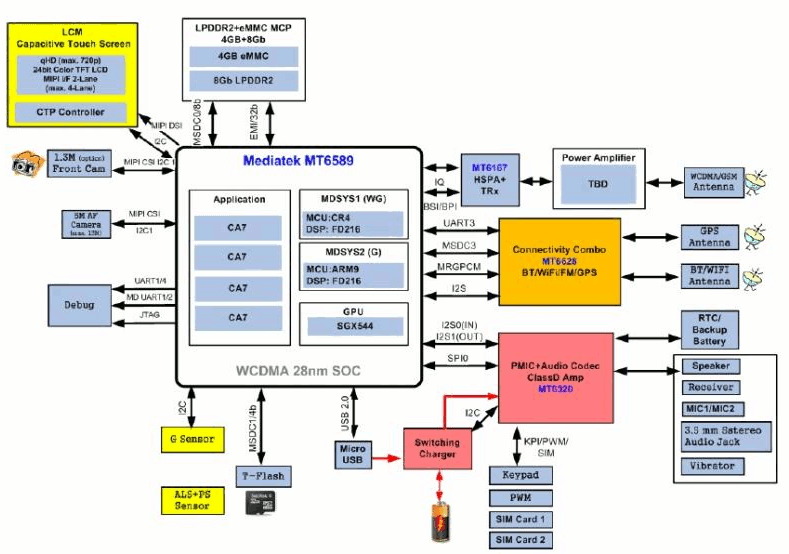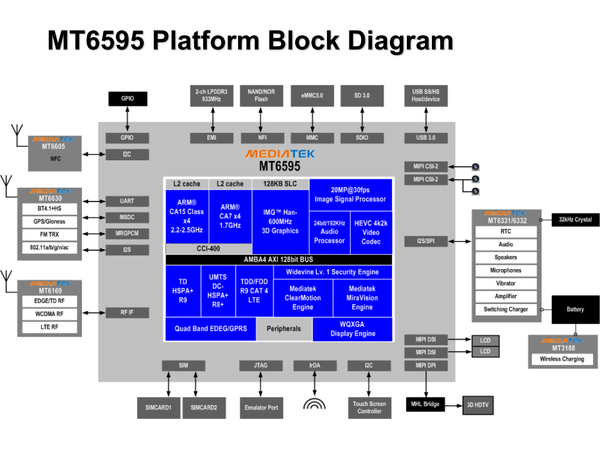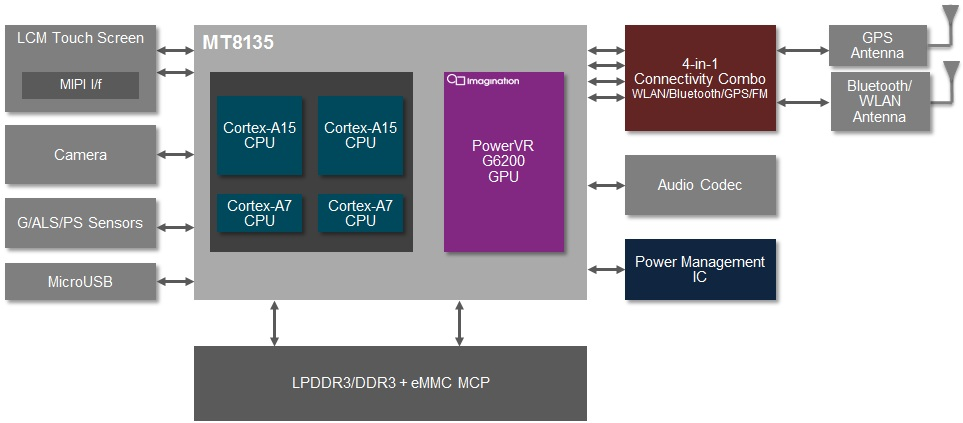The International ARM Race: Rise Of The Chinese SoC
Thanks to low prices and a gradual increase in both quality and performance, Chinese chip makers are starting to pose serious problems for Qualcomm, Nvidia and others.
MediaTek
MediaTek Inc. is a leading fabless semiconductor designer with a focus on 3G GSM HSPA+ and WCDMA phone handsets and phablet SoCs. The company emphasizes power efficiency mixed with performance and, up until recently, built around Cortex-A7, coupling lower-power ARM7 CPUs with a potent GPU to deliver SoCs that save battery while offering comprehensive application and multimedia performance.
Smartphone Chips
| SoC | CPU Core | GPU Core | Max Resolution | Camera | Video Encode/Decode |
|---|---|---|---|---|---|
| MT6572 | Cortex A7 (2-core) @ 1.3 GHz | Mali-400 MP1 @ 500 MHz | 960x540 | 5MP ISP | 720p @ 30 FPS |
| MT6573 | ARM11 @ 650 MHz | PowerVR SGX531 @ 281MHz | 854x480 | 8MP ISP | 480p @ 30 FPS |
| MT6575 | Cortex A9 (1-core) @ 1.0 GHz | PowerVR SGX531 Ultra @ 522 MHz | 960x540 | 5MP ISP | 720p @ 30 FPS |
| MT6577 | Cortex A9 (2-core) @ 1.0 GHz | PowerVR SGX531 Ultra @ 522 MHz | 1280x720 | 8MP ISP | 1080p @ 30 FPS |
| MT6589 | Cortex-A7 (4-core) @ 1.2 GHz | PowerVR SGX544 @ 286 MHz | 1920x1080 | 13MP ISP | 1080p @ 30 FPS |
| MT6592 | Cortex-A7 (8-core) @ 1.7-2.0 GHz | Mali-450 @ 700 MHz | 1920x1080 | 16MP ISP | 1080p @ 30 FPS (h.265 support) |
| MT6595 | Cortex A7 (4-core) @ 1.7 GHz/Cortex A17 (4-core) @ 2.2 GHz | PowerVR 6200 @ 600 MHz | 2560x1600 | 20MP ISP | 2160p @ 30 FPS (h.265 support) |
| MT6732 | Cortex A53 (4-core) @ 1.5 GHz | Mali-T760 MP2 @ 500 MHz | 1920x1080 | 13MP ISP | 2160p @ 30fps(h.265 support) |
MT6572
The MT6572 is one of MediaTek's newer chips, released in 2013. It’s aimed a low-end devices, and consists of a dual-core 1.2 GHz Cortex-A7 CPU and Mali-400 MP1 graphics engine at 500 MHz. As you might imagine, it doesn’t support very high resolutions; its limit is 960x540p. The hardware also can't record video at higher than 720p and 30 FPS. But for an entry-level SoC, not much more can be expected.
MT6573
The MT6573 is based on the much older ARMv6 architecture, most likely for cost reasons. MediaTek still seems to be using it for ultra-cheap smartphones that have only the bare minimum of performance required to power Android, although with Cortex-A7 becoming almost ubiquitous for the low end, it should be on its way out within a year. The chip can't support resolutions and video playback higher than 480p, but it does seem to support 8 MP cameras.
MT6575
While the Cortex-A9 core is also pretty old, it still appears in some devices. Performance-wise, it should be between the MT6573 and MT6572, because the latter is higher-clocked and has two cores. The chip comes with support for display resolutions of up to 960x540 and 720p video playback, along with support for 8 MP cameras.
MediaTek made a cheaper version of this SoC back in 2012. Called MT6575M, it had a GPU that was half as powerful and was manufactured using an older 65 nm process.
MT6577
The MT6577 SoC also utilizes the older Cortex-A9 (in dual-core trim, operating at 1 GHz). MediaTek keeps selling the processor because of its popularity, which enabled a lot of phones to shoot 720p video back in 2012.
Despite its age, the chip continues to support 720p display resolutions, full-HD video playback, and 8 MP cameras, making it a valuable offering from MediaTek at the right price.
Get Tom's Hardware's best news and in-depth reviews, straight to your inbox.
MT6589 and Variants
The MTK6589 is another popular offering. It’s so in-demand, in fact, that MediaTek created another two versions of this chip: one slower (MT6589M) and one faster (MT6589T).
| SoC | CPU Core | GPU Core | Max Resolution | Camera | Video Encode/Decode |
|---|---|---|---|---|---|
| MT6589M | Cortex-A7 (4-core) @ 1.2 GHz | PowerVR SGX544 @ 156 MHz | 960x540 | 8MP ISP | 720p @ 30 FPS |
| MT6589 | Cortex-A7 (4-core) @ 1.2 GHz | PowerVR SGX544 @ 286 MHz | 1920x1080 | 13MP ISP | 1080p @ 30 FPS |
| MT6589T | Cortex-A7 (4-core) @ 1.5 GHz | PowerVR SGX544 @ 357 MHz | 1920x1080 | 13MP ISP | 1080p @ 30 FPS |
All three are based on the Cortex-A7 CPU, and all are quad-core. But the M version has half the GPU performance, supports cameras up to 8 MP, and can only play 720p video. The T version is 25 percent faster for both its CPU and GPU, and supports cameras up to 13 MP. All three of them use PowerVR GPUs from Imagination.
MT6592
The MT6592 is an eight-core Cortex-A7-based chip that runs between 1.7 and 2.0 GHz (typically 1.7 GHz), and comes with a Mali-450 MP4 GPU operating at 600 MHz. This chip can support cameras up to 16 MP, and you'll typically see it in higher-end Chinese smartphones that cost about half as much as the flagships we’re used to.
MT6595
The MT6595 isn't available yet, but it should be by the end of the year. This chip shows that MediaTek wants to compete against Qualcomm and Samsung near the high end of the market. The upcoming SoC will employ ARM’s big.LITTLE power optimization technology with a quad-core Cortex-A7 cluster clocked at 1.7 GHz and a quad-core Cortex-A17 cluster operating at 2.2 GHz. Of course, -A17 is a new core design from ARM that promises roughly twice the performance of Cortex-A7 at a given frequency, or around the same performance as the latest revision of Cortex-A15 (like the one from Tegra K1).
The new SoC will be coupled with a PowerVR 6200 GPU clocked at 600 MHz. It will also bring support for 20 MP cameras and 802.11ac Wi-Fi, in addition to integrating an LTE modem.
MediaTek must expect the chip to be very popular, because it's making two other versions of it: the MT6595M, which will have the Cortex A7 cores clocked at 1.5GHz, and the high-end Cortex A17 cores at 2.0 GHz, and the MT6595 Turbo, which will have its Cortex A7 cores clocked at 1.7 GHz and the Cortex A17 cores at 2.4-2.5 GHz.
MT6732
At this year's Mobile World Conference, MediaTek announced its first ARMv8-based 64-bit chip, the MT6732, which comes with a quad-core Cortex-A53 complex running at 1.5 GHz and a powerful Mali T760 GPU boasting OpenGL ES 3.0 and OpenCL 1.2 support.
The chip supports dual-band 802.11n Wi-Fi, Bluetooth 4.0, LTE, an ISP supporting 13 MP sensors, and 1080p video at 30 FPS, with hardware-accelerated HEVC decoding.
Tablet chips
| Soc | CPU Core | GPU Core | Max Resolution | Camera | Video Encode/Decode |
|---|---|---|---|---|---|
| MT8127 | Cortex A7 (4-core) @ 1.5 GHz | Mali-450 MP4 @ 600 MHz | 1920x1080 | 13MP ISP | 1080p @ 30 FPS |
| MT8377 | Cortex A9 (2-core) @ 1.2 GHz | IMGSGX531 Ultra @ 400 MHz | 1280x720 | 8MP ISP | 1080p @ 30 FPS |
| MT8135 | Cortex A15 (2-core) @ 1.7 GHz / Cortex A7 (2-core) @ 1.2 GHz | IMGG6200 @ 600 MHz | 1920x1080 | 13MP ISP | 1080p @ 30 FPS |
| MT8125 / 8389 | Cortex A7 (4-core) @ 1.5 GHz | IMGSGX544 @ 300 MHz | 1920x1080 | 13MP ISP | 1080p @ 30 FPS |
MT8127
The latest chip announced by MediaTek (MT8127) was designed specifically for tablets on which customers tend to watch more videos and movies. Unlike the MT6732, though, this is not meant as a high-end chip from MediaTek, but as a more low-cost SoC for low-end and mid-range tablets. As such, it comes with quad-core 1.5 GHz Cortex-A7 CPU, a Mali-450 MP4 GPU, and support for 1080p displays, 1080p video playback, and 13 MP cameras.
MT8377
The MT8377 is a lower-end offering for tablets, which was released last year. It comes with a dual-core 1.2 GHz Cortex-A9 CPU made with the older 40 nm process and a PowerVR SGX531 Ultra GPU, which supports a maximum resolution of 1280x720. It also supports Bluetooth 4.0, Wi-Fi, and GSM/GPRS/EDGE/HSPA modems.
MT8135
This is currently MediaTek's highest-end 32-bit tablet chip, which takes advantage of big.Little technology by integrating two Cortex-A15 cores at 1.7 GHz and two Cortex-A7 cores at 1.2 GHz. It also comes with a PowerVR Series6 G200 GPU that supports OpenGL ES 3.0. Tablets incorporating this processor should be capable of respectable gaming performance, even at 1080p.
MT8125/8389
These two chips are MediaTek's older "high-end" products for tablets that have been shipping since last year. They both support 1080p displays and 1080p video playback, along with cameras up to 13 MP. The difference between them is that the MT8389 packs an embedded GPS module and comes with Bluetooth 4.0 support. Both work with wireless standards like GSM, GPRS, EDGE and HSPA+.
Lucian Armasu is a Contributing Writer for Tom's Hardware US. He covers software news and the issues surrounding privacy and security.
-
jossrik It'll be interesting to see where manufacturing goes in the future, maybe back to EU or even Africa somewhere maybe. Right now it's hard to see things get cheaper than China, but of course, eventually it will happen. I hear Apple is gonna buy China.Reply -
Draven35 ReplyThe company's first commercial foray using this technology came in 1983 with the 16-bit Acorn RISC Machine, or ARM. It ran one of the first true multitasking operating systems in production, RISC OS,
Except, the first silicon didn't exist until 1985, and the machine running RISC OS didn't exist until 1987. -
blubbey ReplyGod bless, America. If you can't beat them, join them!
ARM are British though..... (unless I'm missing something which is entirely possible). -
virtualban The Chinese may leech off and profit from current available designs, and close-source their 'innovations', but I wonder what will they do when the rest of the world will reverse engineer and use any progress they make without having to answer to the Chinese companies (duh).Reply -
icemunk The writer seems to think the RK3288 is a 2015 SOC, however it has been out since April, and many devices are available with it, lots of $200 tablets with 2000X1500 resolution, and a bunch of TV boxes as well for $100. It's an excellent chip, achieving around 40,000 antutu scores. 2015 I'm sure we'll see a brand-new Rockchip, but the RK3288 has been out for some time.Reply -
Reply
MediaTek is Taiwanese not Chinese
remove it from the list
Since when is Taiwanese not Chinese? Read a book. -
oxiide Reply
Hopefully your books mention that the Republic of China (Taiwan) and the People's Republic of China (mainland China) are two distinct and, for the most part, recognized nations.MediaTek is Taiwanese not Chinese
remove it from the list
Since when is Taiwanese not Chinese? Read a book.
MediaTek is indeed a Taiwanese company, though I'd rather they just specify that in the article rather than being told to remove it over a technicality. It's still relevant to the topic regardless of where they are headquartered. -
amk-aka-Phantom Thanks to the author for pointing out the closed-source BS, this makes me hate Mediatek. Others are irrelevant (luckily) so far, don't see their chips in any reasonable devices.Reply





